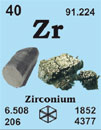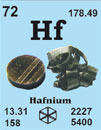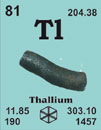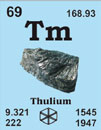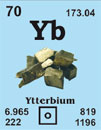Hafnium 72Hf178.49
Discovered in 1923 by D. Coster and G.C. von Hevesey at Copenhagen, Denmark.
[Latin: Hafnia = Copenhagen]
French: hafnium
German: hafnium
Italian: afnio
Spanish: hafnio
Description: Hafnium is a lustrous, silvery, ductile metal that resists corrision due to an oxide film on its surface. However, powdered hafnium will burn in air. The metal is unaffected by acids (exept HF) and alkalis. It is used in control rods for nuclear reactors, and in high temperature alloys and ceramics.
Hafnium single crystal properties
| State: |
Single crystal |
|---|
| Crystal structure: |
hexagonal |
|---|
| Production method: |
Floating zone |
|---|
| Standard size: |
diameter 7-8mm
thickness 1mm |
|---|
| Orientation: |
(0001) |
|---|
| Orientation accuracy: |
<2°, <1°, <0.4° or <0.1° |
|---|
| Polishing: |
as cut, one or two sides polished |
|---|
| Roughness of surface: |
<0.03 µm |
|---|
| Purity: |
99.99% |
|---|
Further Materials properties
| Crystal structure: |
(cell dimensions/pm), space group
a-Hf h.c.p. (a=319.46, c=505.10), P63/mmc
b-Hf cubic (a=362)
T(a -> a)=2033 K |
|---|
| X-ray diffractions mass absorption coefficients: |
CuKa 159 (µ/r) / cm2g-1
MoKa 91.7 (µ/r) / cm2g-1 |
|---|
| Neutron scattering length: |
0.777 b/10-12 cm |
|---|
| Thermal neutron capture cross-section: |
104 sa / barns |
|---|
| Density: |
13.1 kg/m-3 [293 K]; 2390 [liquid at m.p.] |
|---|
| Melting point: |
2229.85 °C / 2503 °K |
|---|
| Boiling point: |
5196.85 °C / 5470 °K |
|---|
| Molar volume: |
13.41 cm3 |
|---|
| Thermal conductivity: |
23.0 [300 K] Wm-1K-1 |
|---|
| Coefficient of linear thermal expansion: |
5.9 x 10-6 K-1 |
|---|
| Electrical resistivity: |
35.1 x 10-8 [293 K] Wm |
|---|
| Mass magnetic susceptibility: |
+5.3 x 10-9(s) kg-1m3 |
|---|
| Young's modulus: |
141 GPa |
|---|
| Rigidity modulus: |
56 GPa |
|---|
| Bulk modulus: |
109 GPa |
|---|
| Poisson's ratio: |
0.26 |
|---|
| Radi: |
Hf3+ 84; atomic 156; covalent 144 |
|---|
| Electronegativity: |
1.3 (Pauling); 1.23 (Allred); 3.8 eV (absolute) |
|---|
| Effective nuclear charge: |
3.15 (Slater); 9.16 (Clementi); 13.27 (Froese-Fischer) |
|---|
| Number of Isotopes (incl. nuclear isomers): |
33 |
|---|
| Isotope mass range: |
158 -> 184 |
|---|
Biological data
| Biological role: |
none |
|---|
| Toxicity |
|
|---|
| Toxic intake: |
hafnium and hafnium salts generally have low toxicity |
|---|
| Lethal intake: |
LD50 (chloride, oral, rat)=2400 mg kg-1 |
|---|
| Hazards: |
Hafnium is poorly absorbed by the body and poisoning by hafnium compounds is very rare. |
|---|
| Level in humans |
|
|---|
| Organs: |
n.a. |
|---|
| Daily dietary intake: |
n.a. |
|---|
Total mass of element in average
[70 kg] person: |
n.a. |
|---|
Geological data
| Minerals: | Many minerals are known, and aluminium is present in many other minerals |
|---|
| Mineral | Formula | Density | Hardness | Crystal apperance |
|---|
| Hafnon |
HfSiO4 |
6.97 |
n.a. |
tet. |
| Chief ore: |
hafnium is obtained as a by-product of zirconium refining |
|---|
| World production: |
c. 50 tonnes/year |
|---|
| Main mining areas: |
see zirconium |
|---|
| Reserves: |
n.a. |
|---|
| Specimen: |
available as foil, pieces, powder sponge or wire. Safe. |
|---|
| Abundances |
|
|---|
| Sun: |
6 (relative to H = 1 x 1012) |
|---|
| Earth's crust: |
5.3 ppm |
|---|
| Seawater: |
7 x 10-6 ppm |
|---|
| Residence time: |
n.a. |
|---|
| Classification: |
n.a. |
|---|
| Oxidation state: |
IV |
|---|
Source: Emsley, J. (1998) The Elements (3rd Edition)
Other sizes and specifications on request

 English
English
 Deutsch
Deutsch








































